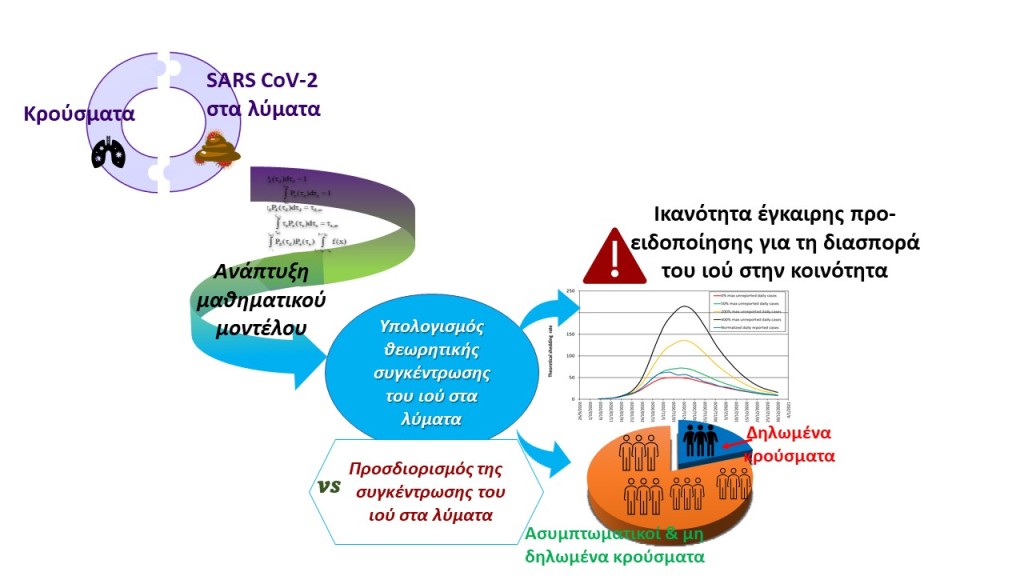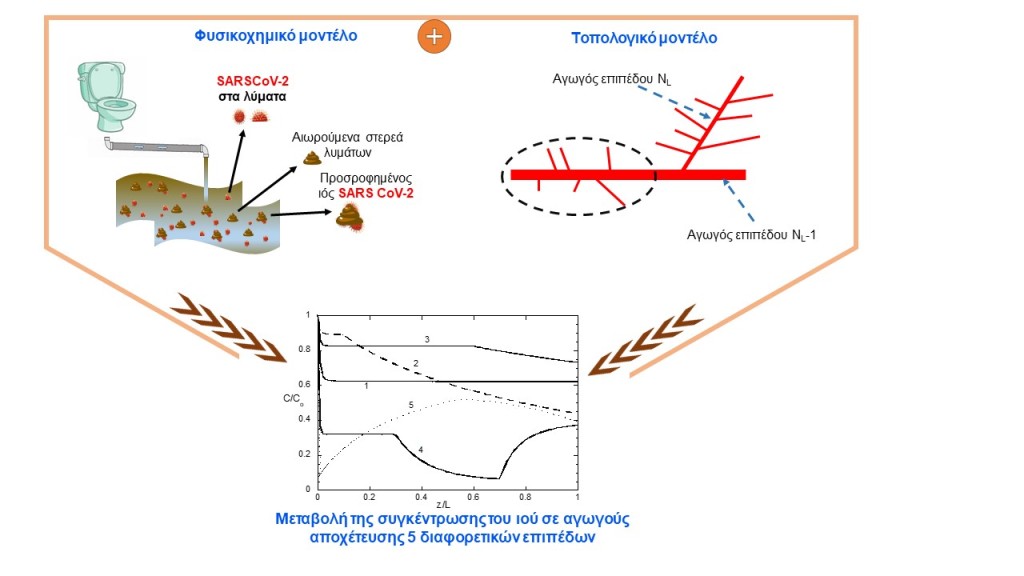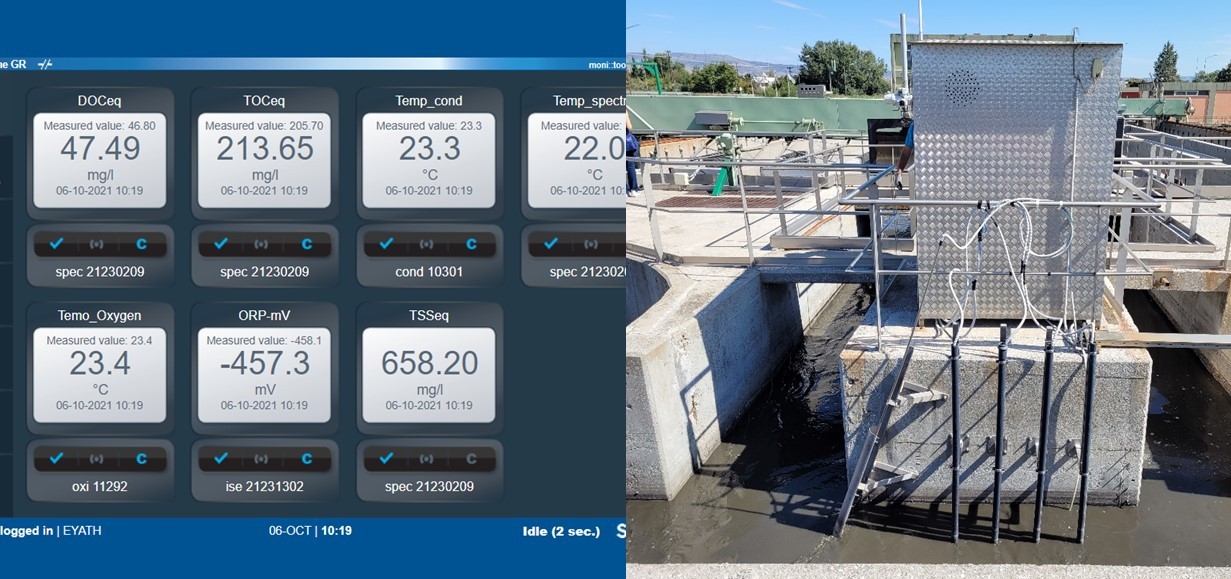Since the beginning of the spread of the SARS-CoV-2 virus in Greece, the Aristotle University of Thessaloniki has put all its forces at the disposal of the Greek state, with the aim of providing scientific support for critical decisions to deal with the pandemic. In this context, in March 2020 it was set up under his coordination Rector of AUTh, Professor Nikolaos G. Papaioannou, the Sewage Epidemiology Team of the Aristotle University of Thessaloniki with scientists of various specialties, with the object of systematic monitoring of the presence of the SARS-CoV-2 virus in the municipal wastewater of Thessaloniki. The purpose was to quantify the temporal evolution of viral load secretion values in the population of Thessaloniki.
The team of AUTh, together with the Water Supply and Sewerage Company of Thessaloniki (EYATH), in collaboration with the Region of Central Macedonia and within the National Sewage Epidemiology Network of EODY, monitors the evolution of measurements in samples taken at the entrance of the Thessaloniki Sewage Treatment Plant. . The AUTh team offered immediately available scientific equipment and know-how, procured the necessary biochemical and chemical consumables and allocated the time to a significant number of specialized researchers and scientists for the analysis of urban wastewater in Thessaloniki.
In the sewerage networks of cities end up man-made waste which contains body fluids (urine, saliva, sweat, blood, respiratory secretions), liquids from washing the body and clothes, feces, impurities etc. All of the above contain human biological material and of course in In the case of the current pandemic, it also includes the representative genome of the SARS-CoV-2 virus, which comes from people who are either sick or asymptomatic carriers of the virus. According to the international literature, wastewater does not contain active infectious virions but fragments of the virus which are inactive for the transmission of the disease but are capable of detecting and quantifying the presence of the virus. Determination of the concentration of the virus genome in the effluent is a quantitative indicator of the level of spread of the virus throughout the community (and not only in symptomatic patients of the virus) and in addition the secretion of viral load in the effluent begins a few days earlier. became infected. For these two reasons, wastewater measurements are a timely and valid indication of the extent of the virus spreading in the community and should be used in addition to medical epidemiological surveillance for decision making.
Contrary to the usual practice of analyzes by individual laboratories for virus detection in wastewater, the AUTh team innovates with the horizontal interdisciplinary approach to the problem. Thus, in addition to molecular biologists and virologists for the detection and quantification of the virus, a medical team of infectious disease specialists assists in the clinical correlation and evaluation of the measurements. In addition, there is a team of environmental engineers for the initial processing of the samples and a series of measurements of environmental parameters, as well as a team of chemicals for performing chemical analyzes, in order to assess possible obstructions or alterations in the detectable amount of virus from other dissolved or dispersed materials. effluent. In addition, the team is complemented by researchers specializing in the development of theoretical physicochemical models for the rationalization of measurements based on the quality characteristics of wastewater. The AUTh wastewater epidemiology team was staffed from time to time by scientists from different laboratories and clinics of the AUTh Departments, such as Medicine (E. Roilidis, A. Papa, S. Metallidis), Chemistry (Th. Karapantsios, M. Costoglou), Veterinary Medicine (N. Papaioannou, Ch. Dovas), Civil Engineering (M. Petala, V. Tsiridis), Pharmaceutical (Th. Sklaviadis), Biology (M. Arsenakis, D. Dafou), and Spatial Planning and Development Engineering (S. Stylianidis).
Although the results of Thessaloniki are used as reference data, the AUTh team is an important member of the National Sewage Epidemiology Network of EODY since its establishment in early 2021 and in this context the results of the AUTh research are of wider national importance, as they concern both in the determination of the best experimental methodology and its application criteria as well as in the process of analysis of the measurements, so that there is reliability and validity in the final results.
Publications in prestigious international scientific journals
Much of the contribution of the AUTh wastewater epidemiology team to the national effort is reflected in the three most innovative of the team’s publications in prestigious international prestigious scientific journals.
In the first publication (Petala, M., Dafou, D., Kostoglou, M., Karapantsios, Th., Kanata, E., Chatziefstathiou, A., Sakaveli, F., Kotoulas, K., Arsenakis, M., Roilides, E., Sklaviadis, T., Metallidis, S., Papa, A., Stylianidis, E. Papadopoulos, A., Papaioannou, N., “A physicochemical model for rationalizing SARS-CoV-2 concentration in sewage. Case study: The city of Thessaloniki in Greece “, Science of the Total Environment, https://doi.org/10.1016/j.scitotenv.2020.142855) the AUTh team presented for the first time in the literature the importance of streamlining the concentration measurements based on the qualitative characteristics of the effluent and developed a complex computational rationalization model, based on advanced physicochemical models that assess possible inhibitions or alterations in the detectable amount of virus from other dissolved or dispersed materials in the effluent. This model was successfully applied to the measurements in the sewage of Thessaloniki, in the period April-June 2020, and led to collaborations with large cities abroad, e.g. Paris, Brussels, Berlin, regarding the analysis of their own measurements in wastewater.
In a subsequent publication (Kostoglou, M., Petala, M., Karapantsios, Th., Dovas, Ch., Roilides, E., Metallidis, S., Papa, A., Stylianidis, E. Papadopoulos, A., Papaioannou , N., “ARS-CoV-2 Adsorption on Suspended Solids along a Sewerage Network: Mathematical Model Formulation, Sensitivity Analysis and Parametric Study”, Environmental Science and Pollution Research 2021, https://doi.org/10.1007/s11356-021 -16528-0), presented for the first time in the literature a methodology (mathematical approach) of the adsorption of virus particles along a sewer network, which is necessary for the evaluation of local measurements of viral load in many different places in a city, taking into account the different residence times within the sewer pipes, as well as the mixing of currents with different chemical and biological characteristics by sewage pipes from different areas of the city.
In a very recent publication (Petala, M., Kostoglou, M., Karapantsios, Th., Dovas, Ch., Lytras, Th., Paraskevis, D., Roilides, E., Koutsolioutsou-Benaki, A., Panagiotakopoulos, G., Sypsa, V., Metallidis, S., Papa, A., Stylianidis, E. Papadopoulos, A., Tsiodras, S., Papaioannou, N., “Relating SARS-CoV-2 shedding rate in wastewater to daily positive tests data: A consistent model based approach “, Science of the Total Environment, 2021, https://doi.org/10.1016/j.scitotenv.2020.150838) the AUTh wastewater epidemiology team presented a pioneering analysis which, through Complex mathematical treatment with population balances and medical data for the different quantitative secretion of viral load from infected carriers in the different days of the disease, allowed for the first time a reliable estimate of the total number of infected people (symptomatic and asymptomatic carriers) of virus concentration in wastewater. The analysis was applied to the measurements of Thessaloniki during the second pandemic wave of November 2020 and revealed that at the peak of the wave the number of asymptomatic carriers had reached five times the number of symptomatic carriers. In the same work, the conditions under which the measurements in the sewage allow the timely recording of the spread of the virus in the community in relation to the classical epidemiological surveillance are analyzed in detail. For Thessaloniki at that time, wastewater measurements preceded 2-4 days of medical surveillance but mainly showed continuity and consistency, in contrast to the large daily fluctuations in the recording of cases, due to the inability of classical surveillance to respond to the very large number of cases .
Promotion of new scientific knowledge and know-how
In addition to the publications, in the daily battle on the field, the AUTh wastewater epidemiology team has promoted scientific knowledge and know-how in the following areas:
It has demonstrated the importance of systematic daily sampling and recording of virus concentration in wastewater, when large cities abroad still count only two or three times a week. Daily sampling allows for the effective evaluation of community-based dispersal indicators, such as the doubling rate, where comparing outcomes with citizen mobility provides evidence of correlation between social behavior and virus spread.
It has evaluated and optimized procedures in the recovery stages of lysate condensation and RNA isolation, targeting two different genomic regions of the virus, performing multiple replications and using appropriate controls to ensure accurate quantification of the virus.
With the support of EYATH, it has installed a special multisensor at the point of entry of wastewater into the EELTH to record, in real time (measurements per minute), a series of physicochemical parameters, with the aim of recording more accurately the time change of wastewater quality characteristics , which are necessary to rationalize viral load values.
With the emergence of Alpha and Delta strains, but also with the recent Omicron strain, the AUTh team in collaboration with other agencies, has successfully worked on the quantitative detection of SARS-CoV-2 mutations in wastewater.
For all the above, relevant announcements have been made in the media and the findings have been made immediately available to the state.
Finally, as early as May 2020, the AUTh sewage epidemiology team had suggested to the Greek state to undertake the establishment of a National Sewage Epidemiology Reference Center to monitor the concentration of SARS-CoV-2 virus in wastewater as an indirect indicator of its degree of spread. virus in cities and housing estates, institutions, migrant accommodation structures, as well as large hotel units during the summer tourist season. This National Reference Center will aim to organize and utilize a database of samples and cases for the recurrence of the current epidemic, as well as for other useful measurements related to public health.
Follow Skai.gr on Google News
and be the first to know all the news
.
I have over 8 years of experience in the news industry. I have worked for various news websites and have also written for a few news agencies. I mostly cover healthcare news, but I am also interested in other topics such as politics, business, and entertainment. In my free time, I enjoy writing fiction and spending time with my family and friends.













